Incline Planes
Learn the forces involved in incline planes with and without friction. See how to solve for acceleration of an object created by the net force.
Forces on an incline
- Fw: Weight
- Longest Vector Straight Down
- Some diagrams may use the variable Fg or mg in place of Fw
Other Real Forces
- FN : Normal Force
- Reaction to the force pushing into the hill (F⟘)and equal and opposite to it
- Ff : Force of Friction
- Reaction to the force pushing down the hill (F⸗ )
Other Component (Phantom) Forces
- F⟘ : Perpendicular Force
- Force pushing into the hill
- F⸗ : Parallel Force
- Force pushing down the hill
Other Symbols
- Ө : Angle of Incline
- Same as angle in the right triangle
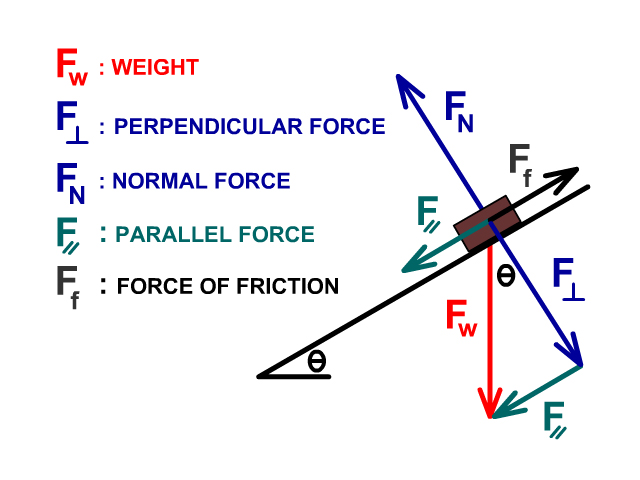
AP Physics Note:
If asked to draw a force diagram, do not include component also called phantom forces. Component forces are part of a real force present and not themselves forces. Weight is a real force and a component of weight is pushing into the hill and down the hill. Components are important to solve problems but not to be included in an actual force diagram if asked to draw one for an exam.
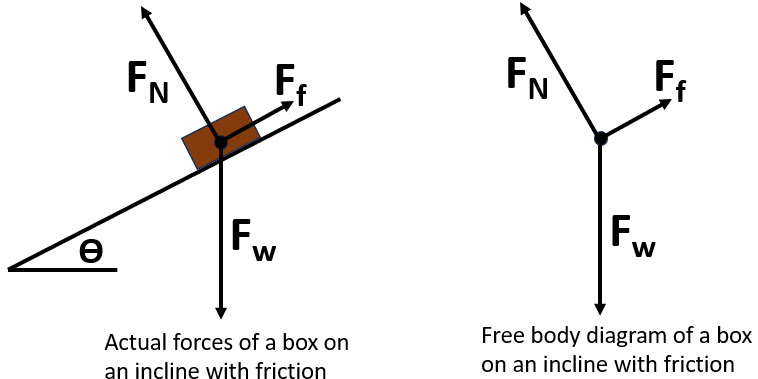
Incline Planes and Trig Functions
Depending what the incline plane question is asking you will use the SOH CAH TOA trig functions. The most common case will be when you are given a mass on a hill and provided the hills incline(Ө). Start by finding weight (FW = mg (g = 10 m/s2). Because you have weight and an incline angle, you now can find other forces involved. These are the most common rearranged forms.
- F⟘ = (cosӨ)(hyp)
- F⸗ = (sinӨ)(hyp)
- FN = F⟘ = (cosӨ)(hyp)
Depending on how a the questions is asked you may need any of the trig functions including tangent.
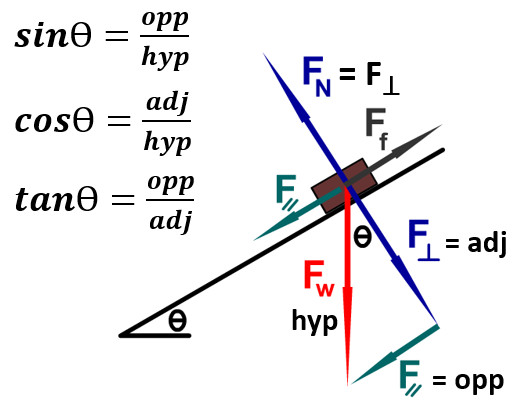
What happens to forces as the incline increases?
- Weight (FW) stays the same
- Normal force (FN) decreases
- Parallel force (F ⸗) increases
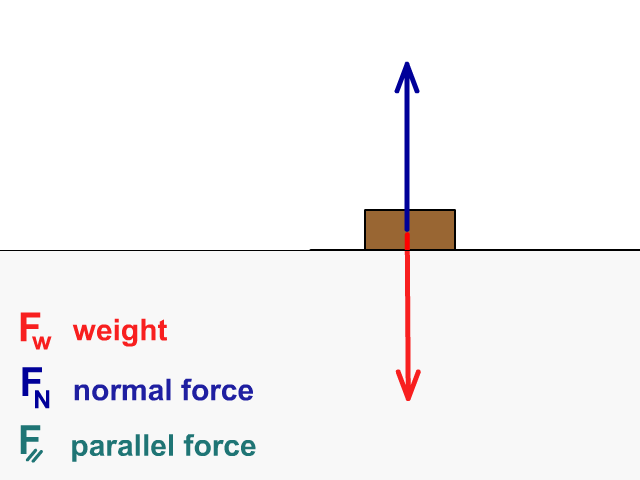
Q1: What other vector is the parallel force equal to if the incline was 90°?
Q2: Why would friction decrease as the angle of incline increases?
What happens to acceleration as the incline increases?
As an incline angle increases parallel force increases while frictional force decreases as a result of normal force going down.
Fnet = F⸗ – Ff
Net force and acceleration increase as the angle increases
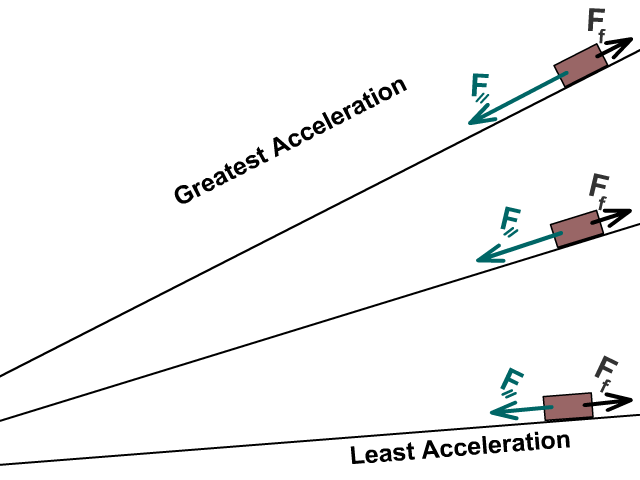
Solving for forces on an incline
Weight
FW = (mg)
hyp = (mg)
Perpendicular Force
F⟘ = (cosӨ)(hyp)
F⟘ = (cosӨ)(FW)
F⟘ = (cosӨ)(mg)
Parallel Force (Downhill Force)
F⸗ = (sinӨ)(hyp)
F⸗ = (sinӨ)(FW)
F⸗ = (sinӨ)(mg)
Normal Force
FN = F⟘ = (cosӨ)(hyp)
FN = (cosӨ)(FW)
FN = (cosӨ)(mg)

Net Force (Fnet) on a frictionless incline and no applied force
- Net force comes completely from parallel force on a frictionless surface causing acceleration
- F⸗ = Fnet
- Fnet = ma
Finding downhill acceleration (Frictionless)
Fw = (mg)
hyp = (mg)
Find the parallel force substituting (mg) for the hypotenuse which is weight
F⸗ = opp = (sinӨ)(hyp)
F⸗ = (sinӨ)(mg)
The parallel force is the net force so we combine equations
F⸗ = Fnet
Fnet = (sinӨ)(mg)
Fnet = ma
a = ((sinӨ)(mg))/m
m cancels out resulting in an equation to solve for acceleration on an incline with only the angle of incline and acceleration due to gravity (g)
a = (sinӨ)(g)
Equation for solving for acceleration on an incline without friction:
a = (sinӨ)(g)
Questions
A 1.5 kg block is on a 15° frictionless incline plane
Q3: What is the normal force?
Q4: What is the force downhill?
Q5: What is the acceleration?
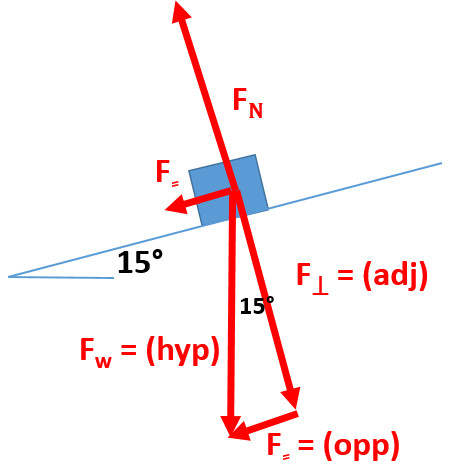
Net Force (Fnet) with friction on an incline and no applied force
Parallel force minus friction is the net force creating acceleration
Use the parallel force downhill
F⸗ = (sinӨ)(mg)
Find friction substituting normal force
Ff = µFN
FN = (cosӨ)(mg)
Ff = µ (cosӨ)(mg)
Net force is the parallel force down the hill minus the force of friction uphill
Fnet = F⸗ - Ff
Fnet = (sinӨ)(mg) - µ (cosӨ)(mg)
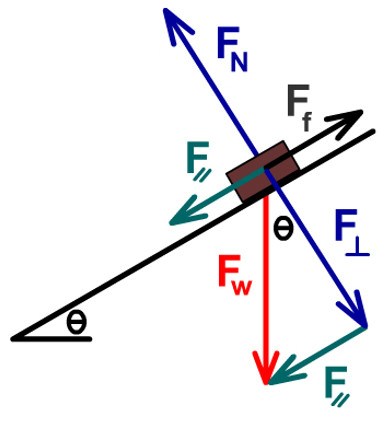
Finding downhill acceleration (with friction)
Fnet = ma
a = ((sinӨ)(mg) - µ (cosӨ)(mg))/m
You then cancel out the mass from the numerator and denominator
a = ((sinӨ)(g) - µ (cosӨ)(g))
which becomes a = (g)((sinӨ) - µ (cosӨ))
Equation for solving for acceleration on an incline with friction:
a = (g)((sinӨ) - µ (cosӨ))
Questions
A 5.3 kg block is on a 25° incline plane with a coefficient of static friction of 0.25 and coefficient of kinetic friction of 0.20
Q4: What is the normal force?
Q5: What is the force downhill?
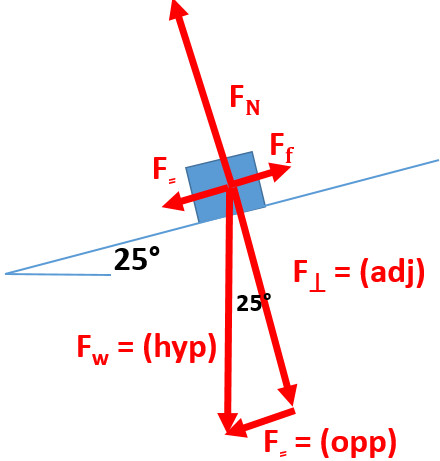
Q6: What is the force of static friction?
Q7: What is the force of kinetic friction?
Q8: Would the block be moving?
Q9: What is the net force on the block?
Q10: What is the block’s acceleration?
Q11: How fast would the block be moving when starting from 2 m/s after 5 seconds?
When a force is applied uphill on an incline
When a force is applied uphill on an incline
Friction will be downhill if motion is uphill
Net Force
Fnet = FA - (F⸗ + Ff)
Fnet = FA - ((sinӨ)(mg) + µ (cosӨ)(mg))
Acceleration
a =Fnet /m
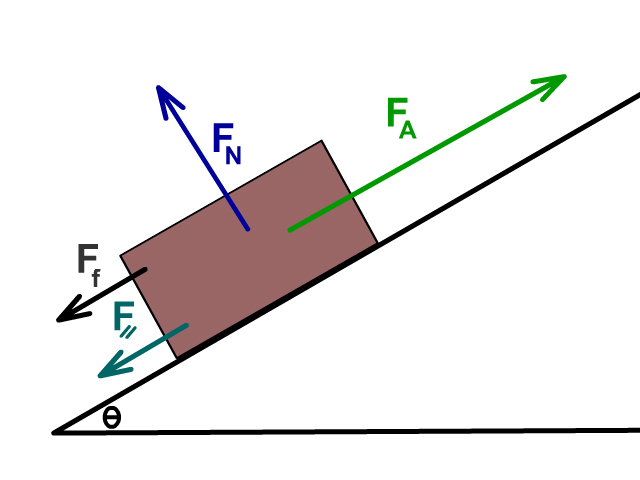
When a force is applied downhill on an incline
Friction will be uphill if motion is downhill
Net Force
Fnet = (FA + F⸗) - Ff
Fnet = (FA + (sinӨ)(mg)) - µ (cosӨ)(mg)
Acceleration
a =Fnet /m
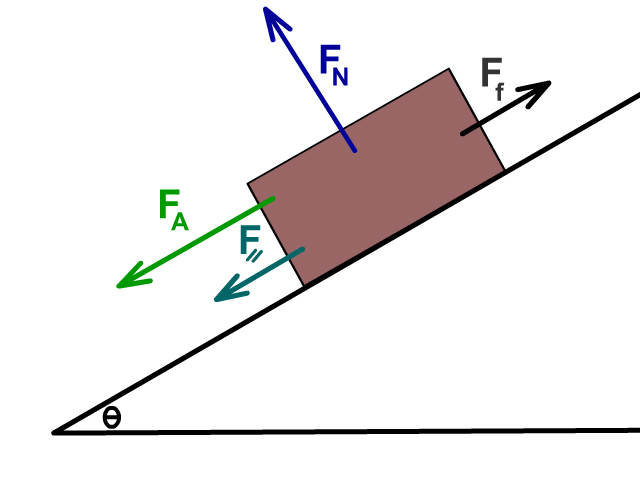
Sam pulls a 30 kg box up a 19° incline that has a coefficient of friction of 0.20 with a force of 200 N
Q12: What is the net force?
Q13: What is the acceleration?
Links
- On to Hooke's Law
- Back to the Main Forces Page
- Back to the Stickman Physics Home Page
- Equation Sheet
